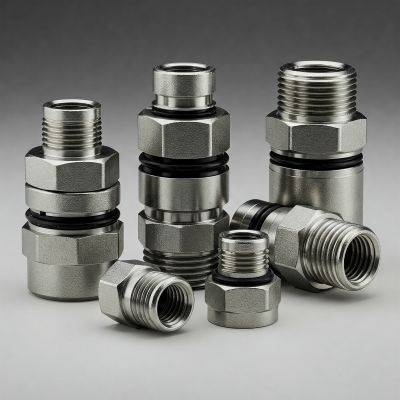Hydraulic systems play a crucial role in industrial applications, enabling the efficient transmission of power in heavy machinery, construction equipment, and manufacturing processes. These systems rely on high-quality fittings to ensure leak-free and reliable performance under extreme pressure conditions.
Compression thread fittings are essential components in hydraulic systems, providing a secure and durable connection between pipes, hoses, and other hydraulic components. They help prevent fluid leakage, reduce downtime, and enhance the overall efficiency of hydraulic operations. In high-pressure environments, heavy-duty compression thread fittings are particularly important for maintaining system integrity and safety.
Understanding Compression Thread Fittings
What Are Compression Thread Fittings?
Compression thread fittings are hydraulic connectors designed to create a secure, leak-proof seal between pipes or hoses without the need for welding or soldering. They use a compression mechanism, typically involving ferrules or sleeves, to grip and seal the tubing tightly when the fitting is tightened.
How They Differ from Other Hydraulic Fittings
Unlike other hydraulic fittings such as flare fittings or O-ring face seal fittings, compression thread fittings do not require special flaring or preparation of the tubing. They provide a straightforward installation process, making them ideal for high-pressure applications where reliability and ease of use are critical.
Types of Compression Thread Fittings
Single Ferrule vs. Double Ferrule:
➡️ Single ferrule fittings use one compression ring to secure the tubing, offering a simpler and cost-effective solution.
➡️ Double ferrule fittings have two rings for enhanced grip and sealing, making them suitable for extreme pressure and vibration environments.
Common Thread Types:
➡️ BSP (British Standard Pipe)
➡️ JIC (Joint Industry Council)
Materials Used in Heavy-Duty Fittings
➡️ Stainless Steel: Offers excellent corrosion resistance and strength, ideal for harsh environments.
➡️ Brass: Provides good machinability and corrosion resistance, commonly used in lower-pressure applications.
➡️ Carbon Steel: High strength and durability, suitable for heavy industrial use.
Corrosion resistance and durability are key factors in selecting the right material to ensure longevity and reliable performance in hydraulic systems.
Why Use Heavy-Duty Compression Thread Fittings?
➡️ Superior Strength and Durability: Designed to withstand high-pressure applications, heavy-duty fittings provide robust connections that can handle extreme operating conditions.
➡️ Leak-Proof Sealing: The compression mechanism ensures a tight, secure fit, preventing hydraulic fluid loss and maintaining system efficiency.
➡️ Compatibility with Various Hydraulic Systems: These fittings are used across multiple industries, including construction, manufacturing, aerospace, and oil & gas.
➡️ Ease of Installation and Maintenance: Unlike welded or flared fittings, compression thread fittings are easier to install and replace, reducing downtime and operational costs.
Applications of Heavy-Duty Compression Thread Fittings
➡️ Industrial Hydraulic Machinery: Used in presses, pumps, and hydraulic cylinders to maintain efficient power transmission.
➡️ Construction Equipment: Essential for excavators, cranes, and loaders where high-pressure fluid transfer is required.
➡️ Aerospace and Defense: Applied in aircraft hydraulic systems and military vehicles for reliable fluid transport.
➡️ Oil & Gas Industry: Used in pipelines and offshore drilling rigs to handle high-pressure and corrosive environments.
➡️ Agricultural Machinery: Found in tractors, irrigation systems, and harvesters for effective fluid control.
Choosing the Right Compression Thread Fitting
Factors to Consider:
➡️ Pressure Rating and Temperature Compatibility: Ensure the fitting can handle the system’s operating conditions.
➡️ Material Selection: Choose the right material based on environmental factors like corrosion and chemical exposure.
➡️ Thread Type and Size: Ensure compatibility with existing hydraulic components.
➡️ Corrosion and Chemical Resistance: Consider the working environment to prevent premature fitting failure.
Best Practices for Selection:
➡️ Check Compatibility with Hydraulic Fluid: Verify that the fitting material is compatible with the hydraulic fluid in use.
➡️ Ensure Compliance with Industry Standards: Look for fittings that meet standards such as ISO, SAE, and DIN to guarantee quality and performance.
Installation and Maintenance Tips
How to Install Compression Thread Fittings Properly
➡️ Ensure the tubing is clean and free of debris before installation.
➡️ Insert the tubing into the fitting and tighten according to the manufacturer’s specifications.
➡️ Avoid over-tightening, which can damage the ferrule and compromise the seal.
Common Installation Mistakes to Avoid
➡️ Using incorrect thread types or sizes.
➡️ Over-tightening or under-tightening the fitting.
➡️ Failing to inspect the fitting for defects before installation.
Regular Maintenance for Longevity
➡️ Inspect for Wear and Corrosion: Regularly check fittings for signs of damage or wear.
➡️ Replace Worn-Out Fittings: Prevent leaks and failures by replacing fittings that show signs of wear.
Troubleshooting Common Issues
➡️ Leaks: Check for improper installation, damaged ferrules, or worn-out fittings.
➡️ Improper Sealing: Ensure the fitting is correctly tightened and that the tubing is properly seated.
➡️ Thread Damage: Replace fittings if threads are stripped or damaged.
Conclusion
Heavy-duty compression thread fittings are essential for ensuring reliable and leak-proof hydraulic connections in high-pressure systems. Their durability, ease of installation, and compatibility with various applications make them a preferred choice across industries.
Selecting high-quality fittings that meet industry standards is crucial for safety and performance. By understanding the different types, materials, and best practices for installation and maintenance, businesses can maximize the efficiency and lifespan of their hydraulic systems.
For expert advice or to find the right fittings for your needs, consult a trusted hydraulic supplier today [Sannke.com].
Post time: Apr-16-2025


